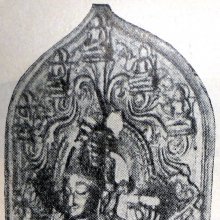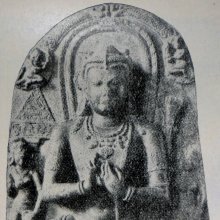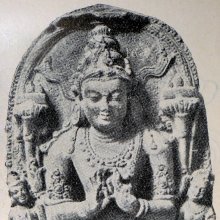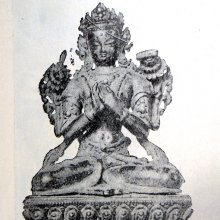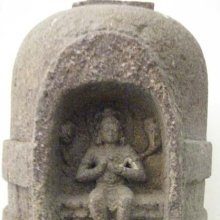Manjuvara, Mañjuvara: 2 definitions
Introduction:
Manjuvara means something in Buddhism, Pali, Hinduism, Sanskrit. If you want to know the exact meaning, history, etymology or English translation of this term then check out the descriptions on this page. Add your comment or reference to a book if you want to contribute to this summary article.
Images (photo gallery)
(+6 more images available)
In Buddhism
Tibetan Buddhism (Vajrayana or tantric Buddhism)
Source: archive.org: The Indian Buddhist IconographyMañjuvara (मञ्जुवर) refers to one of the various forms of Mañjuśrī having their Sādhana described in the 5th-century Sādhanamālā (a collection of sādhana texts that contain detailed instructions for rituals).
Mañjuvara (first variety): his Colour is golden-yellow; his Mudrā is the dharmacakra; his Āsana is the lalita or ārdhaparyaṅka; his Symbol is the prajñāpāramitā on lotus. The Dhyāna (meditation instructions) of Mañjuvara is described in the Sādhanamālā as follows:
“The worshipper should think himself as god Mañjuvara of golden-yellow colour with head decorated with the images of the five Dhyāni Buddhas. His hands display the Dharmacakra-mudrā and he shows the blue lotus bearing the Prajñāpāramitā manuscript. He rides a lion, sits there on in the Lalita attitude and is decked in allornaments... Oṃ Mañjuvara Hūṃ”.
[According to a second Sādhana Mañjuvara should have the lotus in his left hand with the Prajñāpāramitā on it. He may sit in the ardhaparyaṅka attitude and may be accompanied with the fierce god Yamāntaka of blue colour, whose face distorted with bare fangs is terrible to behold. Yamāntaka carries the staff in one of his hands and touches the feet of Mañjuvara with the other.]
Mañjuvara (second variety): his colour is golden-yellow; he has three faces and six arms. This form of Mañjavajra is described in the Niṣpannayogāvalī (Mañjuvajra-maṇḍala) as follows:
“God Mañjuvajra is seated on the back of a lion, is of beautiful golden colour and resembles Vairocana, His three faces have yellow, blue and white colour. He is six-armed. In the three right handshe holds the sword, the Varada-mudrā and the arrow. In the three left likewise he carries the Prajñāpāramitā manuscript, the blue lotus and the bow”
Mañjuvara (third variety): his colour is red; he has six arms. This form of Mañjavajra is also described in the Niṣpannayogāvalī as follows:
“The god Vajrasattva in the form of Mañjuvajra is red like vermillion. His right face is blue and the left white. With the two principal hands he embraces his Prajñā; in the others he carries the sword, the arrow the lotus and the bow”

Tibetan Buddhism includes schools such as Nyingma, Kadampa, Kagyu and Gelug. Their primary canon of literature is divided in two broad categories: The Kangyur, which consists of Buddha’s words, and the Tengyur, which includes commentaries from various sources. Esotericism and tantra techniques (vajrayāna) are collected indepently.
Languages of India and abroad
Sanskrit dictionary
Source: Cologne Digital Sanskrit Dictionaries: Edgerton Buddhist Hybrid Sanskrit DictionaryMañjuvara (मञ्जुवर) or Mañjuśrī.—: Sādhanamālā 108.17 (verse) etc.; (Ārya-)Mañjuśrīmūlakalpa 436.2 (verse). Error for Mañjurava?
Sanskrit, also spelled संस्कृतम् (saṃskṛtam), is an ancient language of India commonly seen as the grandmother of the Indo-European language family (even English!). Closely allied with Prakrit and Pali, Sanskrit is more exhaustive in both grammar and terms and has the most extensive collection of literature in the world, greatly surpassing its sister-languages Greek and Latin.
See also (Relevant definitions)
Full-text: Manjushri.
Relevant text
Search found 3 books and stories containing Manjuvara, Mañjuvara; (plurals include: Manjuvaras, Mañjuvaras). You can also click to the full overview containing English textual excerpts. Below are direct links for the most relevant articles:
The Indian Buddhist Iconography (by Benoytosh Bhattachacharyya)
Sripura (Archaeological Survey) (by Bikash Chandra Pradhan)
Scultures of Manjuvara < [Chapter 3 - Sculptural Programme]
Scultures of Bodhisattvas < [Chapter 3 - Sculptural Programme]
Bronze-icons < [Chapter 3 - Sculptural Programme]
Stupas in Orissa (Study) (by Meenakshi Chauley)
Buddha Images < [Chapter 5]
Emanations of Vairocana < [Chapter 5]
Minor Votive Stupas at Ratnagiri < [Chapter 4]
